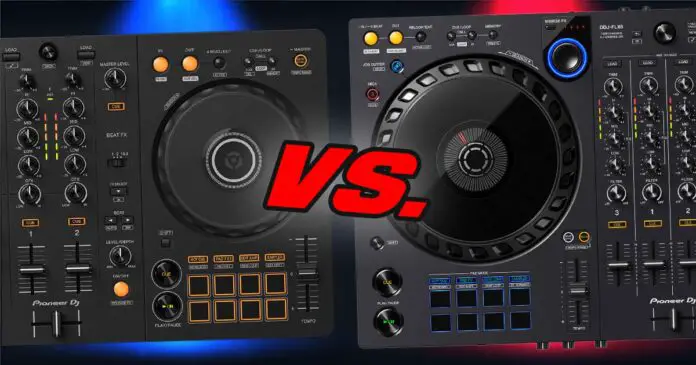The Pioneer FLX series have taken the market by storm and it’s no wonder. These neat line of DJ controllers features models suitable both for beginners and advanced DJs, and in terms of features it’s great value for money! In this hands-on comparison we’re going to take a closer look at both the Pioneer DDJ-FLX4 and the DDJ-FLX6 and see which one of these devices is better for your needs. Let’s get on with the updated review!
- Should you start with the FLX4 or FLX6?
- First things first – the size & weight
- 2 vs. 4 Mixer Channels
- Jog wheels – main differences
- FX controls – pretty similar
- Exclusive features of both controllers
- Compatible DJ software
- Mobile devices support?
- Pioneer DDJ-FLX6-GT?
- Pioneer DDJ-SB3 vs. DDJ-FLX4
- Price and availability
- Pros & cons
- The conclusion – which one should you get?
Check out also: Pioneer DDJ-FLX6 – DJ Controller Overview
This web portal is reader-supported, and is a part of the Amazon Services LLC Associates Program and the eBay Partner Network. When you buy using links on our site, we may earn an affiliate commission!
Should you start with the FLX4 or FLX6?
Well, while the Pioneer DDJ-FLX4 and FLX6 follow the same naming convention, they are actually really different in terms of what they have to offer.
Pioneer DDJ-FLX6 is a DJ controller which while it’s also classified as an entry-level device, features 4 mixer channels, larger jog wheels and in general, a larger chassis. It’s also sold in an updated grey color variant.
The Pioneer DDJ-FLX4, released two years after the FLX4 is an entry-level DJ controller featuring two mixer channels, support for Rekordbox and Serato DJ software and a nice half-portable form factor, with Rekordbox mobile DJ app support to come.
Each of these controllers also have their own exclusive features which we’re going to talk about in a short while.
You can read more about the DDJ-FLX6-GT here: Pioneer DDJ-FLX6-GT – Is It Any Different From The FLX6?
First things first – the size & weight
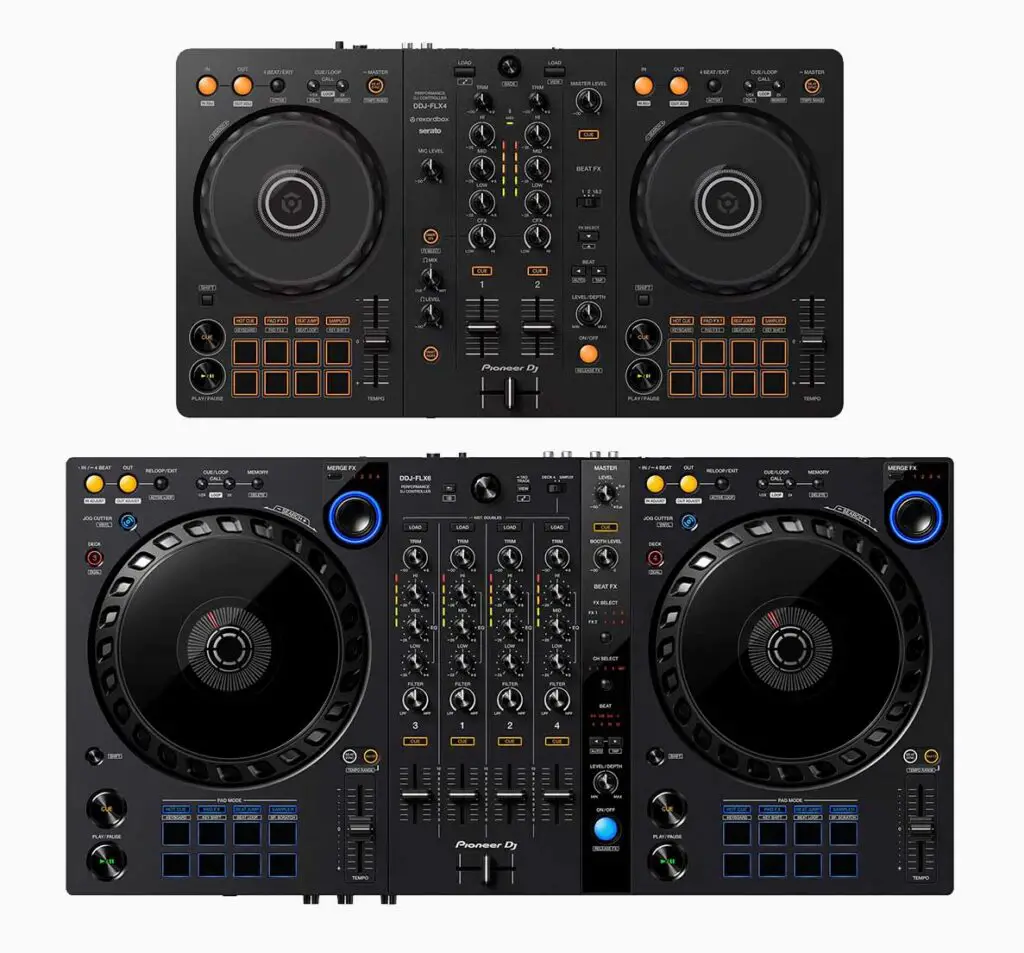
In the picture above you can see the actual side-by-side size comparison between the Pioneer DDJ-FLX4 and DDJ-FLX6. When it comes to the weight of these controllers, the FLX4 weighs around 4.63 lb (2.1 kg), and the FLX6, around 8.38 lb (3.8 kg) – so almost twice as much.
Check out our full hands-on review of the FLX6 here: Pioneer DDJ-FLX6 – DJ Controller Review
As you can see in the supplied image, the Pioneer DDJ-FLX6 is closer in size to higher-end DJ controllers such as the Pioneer DDJ-1000. The Pioneer DDJ-FLX4 on the other hand is almost the exact same size as its predecessor – the Pioneer DDJ-400.
While none of these devices are exactly portable when it comes to their sizes, as you will see in a while, the FLX4 is (will be) compatible with an upcoming Rekordbox DJ app.
2 vs. 4 Mixer Channels
On the FLX6 with 4 mixer available channels you’re generally going to have a little bit more flexibility than on the FLX4.
Having 4 mixer channels is great in terms of future-proofing your setup, however when it comes to entry-level gear you don’t really have to worry about that much – especially as a beginner.
Compared to the Pioneer DDJ-FLX6 there are many different Pioneer DJ devices featuring 4 channels out of the box. Options that can be actually considered a future-proof choice for a first DJ controller, such as the Pioneer DDJ-1000 or DDJ-1000SRT can interest you as well if the FLX6 has already caught your eye – check out our comparison of the DDJ-1000 and 1000SRT here!
Jog wheels – main differences
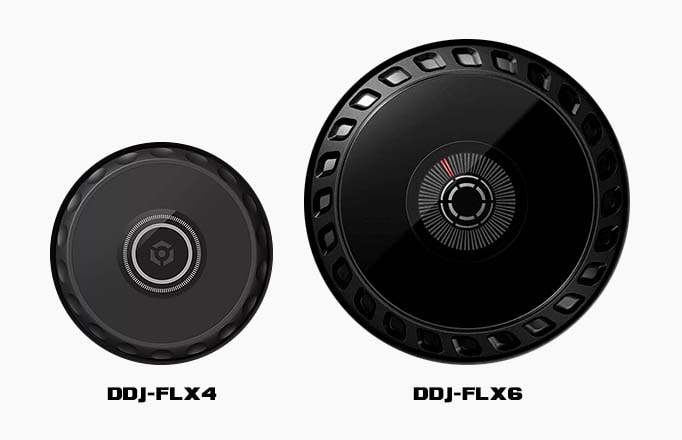
The capacitive jog wheels on the Pioneer DDJ-FLX4 are the same size as the ones present on the DDJ-400 – so around 5″. Their surface is a little bit less of a “fingerprint magnet” than the ones on the DDJ-400 and the DDJ-FLX6 but other wise in terms of sheer functionality these are close to the same.
The Pioneer DDJ-FLX6 has two 8″ jog wheels which are almost the exact same size as the ones present on Pioneer CDJ-2000/3000 players. Don’t let them fool you however, the jog wheel platters on the FLX6 are not mechanical – they make use of the very same capacitive touch detection mechanism that most entry-level DJ controllers utilize.
In summary, the Pioneer DDJ-FLX6 has the slight advantage of bigger jog wheel size and the LED virtual needle indicator in the middle of the platter.
Learn more about different jog wheel types here: Jog Wheel Types Explained – DJ Equipment Guide
FX controls – pretty similar
In terms of audio FX controls, both devices make use of a traditional Pioneer DJ “Beat FX strip” approach in which all main FX controls are located on the right side of the mixer section.
Both DDJ-FLX4 and FLX6 feature much simplified Beat FX implementations which while pretty pleasant to use, don’t come close to the Beat FX strips on the Pioneer DJM mixers (and this is expected at these price points).
In that matter, in terms of basic audio FX controls the FLX4 and the FLX6 are rather similar (and so is the DDJ-400).
Exclusive features of both controllers
Each of these devices have mutually exclusive extra features that you’ll have to choose between if you’ll decide on picking just one of them.
The Pioneer DDJ-FLX4 has its unique Smart CFX and Smart Fader functions, while the Pioneer DDJ-FLX6, has the exclusive access to the Merge FX & Jog Cutter features. Let’s quickly go over all of these.
Smart CFX & Smart Fader on the DDJ-FLX4
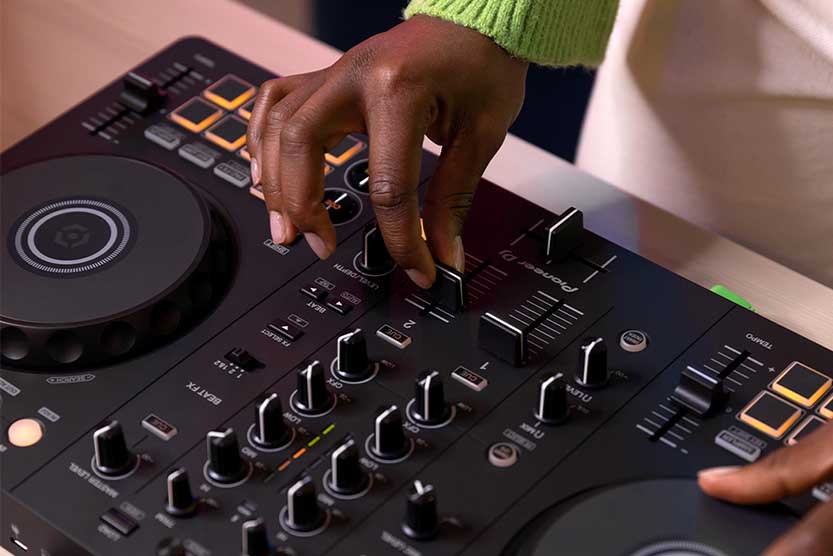
There are two features that are unique to the new Pioneer DDJ-FLX4. These are the Smart CFX & Smart Fader functions.
Smart CFX is similar to the Pioneer DJ Color FX – it enables you to set different creative pre-made audio FX macros to the CFX knobs on the mixer (the knobs under the low EQ knobs).
Here are all the available Smart CFX effects as of now: Phantom Echo, Reflect Echo, Mobius Echo, Vaporize, Noise Chopper, Cyber Jet, Cyber Pitch and Twister.
All these have been recently covered in a video by DigitalDJTips, so you can head over to it for a quick presentation on how they actually sound.
The other feature – the Smart Fader has to do with the FLX4’s crossfader.
When you press the Smart Fader button, you will be able to perform software assisted track transitions with automatic tempo changes alongside with automated echo FX. This feature works the best with tracks that actually differ in tempo by much. It’s quite a nice gimmick!
Both these features are entirely exclusive to the Pioneer DDJ-FLX4 as of now.
Merge FX & Jog Cutter on the DDJ-FLX6
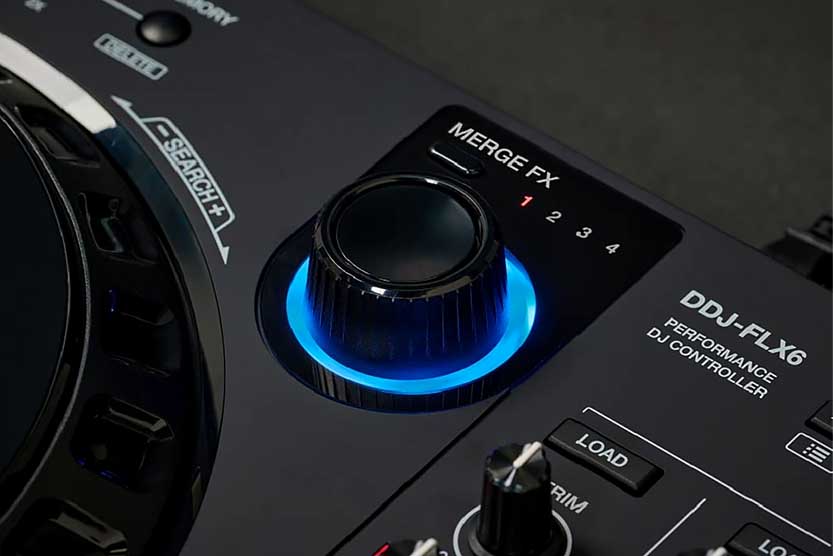
Pioneer DDJ-FLX6 has its own unique features, an these are the Merge FX knobs and the Jog Cutter mode.
Starting with the Merge FX knobs (explained in more detail here), they are in essence there to make transitions between tracks with vastly differing BPM easier (similarly to the Smart Fader on the DDJ-FLX4).
When you activate the Merge FX knob by pressing it, you’ll be able to turn it to use one of a few advanced audio FX macros that will help you to transition out of the track you are currently playing. There are quite a few combinations of the Merge FX with Rekordbox, much less with Serato DJ.
Denon DJ SC Live 4 vs. Prime 4 (Direct Comparison!)
The Jog Cutter mode allows you to mimic scratching without you touching the crossfader – it automates its complex movements for you.
There are a few jog cutter scratches you can make use of – you can choose each of these by activating jog cutter mode and moving the jog wheel platter to one of a few zones. You can read more about the jog cutter mode here.
In all honesty, the jog cutter mode can be really finicky and hard to time well at times. If we were comparing the additional FX features directly, we would absolutely take the Smart CFX on the DDJ-FLX4 over the access to the Jog Cutter function available on the DDJ-FLX6.
Compatible DJ software
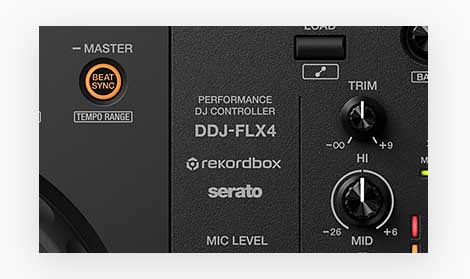
Pioneer DDJ-FLX4 is compatible with both Rekordbox and Serato DJ. But there is a small catch here.
FLX4 works with Serato DJ Lite out of the box, but to use it with Serato DJ Pro, you would have to purchase a software license separately – keep that in mind, as the Lite version of Serato is really limited in comparison to the real-deal Serato DJ Pro.
Learn more about the differences between Serato DJ Lite and Pro: Serato DJ Lite vs. Pro (12 Most Important Differences)
In terms of Virtual DJ, on the official Virtual DJ forums, there are already rumors about the device becoming compatible with VDJ software somewhere later this year. As this is the replacement for the ever-popular Pioneer DDJ-400, it’s only natural that support for DJ software like Virtual DJ and Mixx will come sooner or later when more devices become available on the market.
Pioneer DDJ-FLX6 on the other hand, is also compatible with Rekordbox and Serato, but this device actually will unlock the full version of Serato DJ Pro when plugged into your computer.
With that being said, the support for features such as Merge FX and Performance pad mode labeling and functionality are much worse when using the Serato DJ ecosystem with your DDJ-FLX6. Better stick to Rekordbox for best results!
Mobile devices support?
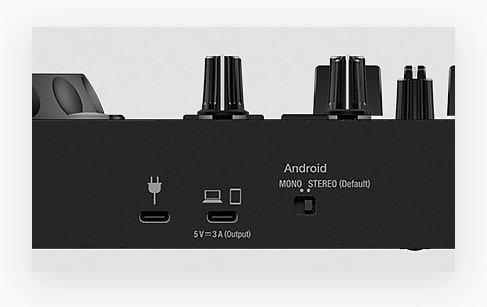
The USB-C port located on the back of the device is prepared for the mobile DJ app support. There is a rumored Rekordbox DJ Mobile App coming soon so stay tuned for that!
We can also find a charging port and an Android “mono-stereo” switch on the back of the DDJ-FLX4 – this might indicate that: the FLX4 will be able to support mobile DJ apps while being simultaneously powered from an external power bank, and it will be compatible with Android OS to some extent.
The presence of the Bluetooth LED on the front panel of the DDJ-FLX4 is also notable. The situation with mobile devices support should clear up somewhere near the end of the year.
Pioneer DDJ-FLX6 doesn’t officially support any mobile apps.
Pioneer DDJ-FLX6-GT?
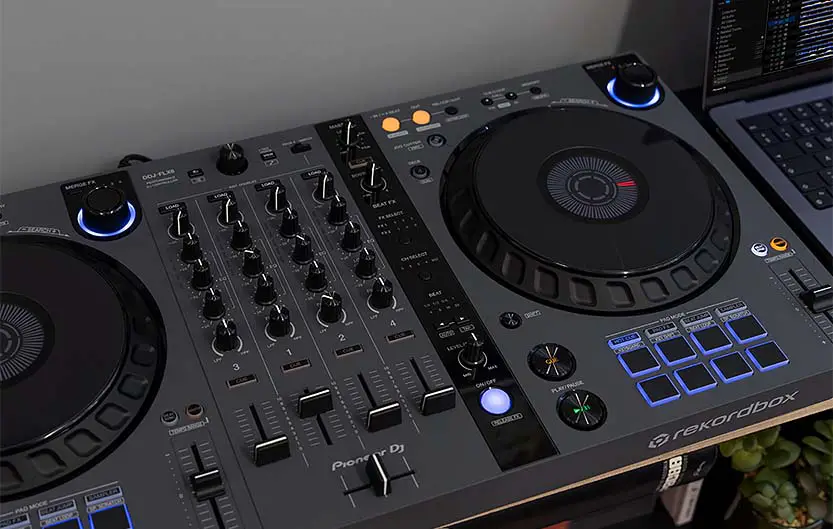
As we’ve already mentioned, after the release of the Pioneer DDJ-FLX4, the older DDJ-FLX6 actually got an updated look with the following release of the Pioneer DDJ-FLX6-GT.
Pioneer DDJ-FLX6-GT – Did Something Change?
While this one is a simple re-skin of the original FLX6, it introduces nice change to the jog wheels finish, which makes them more pleasant to use (and less fingerprint-prone). It’s also nice seeing that the FLX series seems to be finally getting some attention from Pioneer DJ.
Pioneer DDJ-SB3 vs. DDJ-FLX4
This is the comparison that for some reason is searched up quite frequently. Well, first things first, one thing has to be said. The Pioneer DDJ-SB3 is a device that has been discontinued for quite some time now.
In the peak of its popularity the SB3 was an entry-level DJ controller that was aimed at beginners and featured a now forgotten gimmick where you could activate simple automated scratch patterns with a single press of a button.
Nowadays it can still be bought used (for instance here on Ebay), and while it still may be a great pick for beginners if you can find it for a good price, it’s generally considered obsolete. The price of a new Pioneer DDJ-FLX4 will in general always be close to a price of used DDJ-SB3, and when we compare their feature sets directly you’ll realize that there is really no reason to buy an SB3 for a full price these days.
Price and availability
Both Pioneer DDJ-FLX4 and Pioneer DDJ-FLX6 are already readily available in a handful of online stores and marketplaces. Here you can check their availability both in the official Pioneer DJ Amazon store and on Ebay.
It is to be expected, that due to the high demand for Pioneer DJ entry-level devices (which we certainly know from the DDJ-400 shortage episodes) the Pioneer DDJ-FLX4 might get sold out pretty fast.
| Controller | Features | Price |
|---|---|---|
| Pioneer DDJ-FLX4: – Affordable entry-level device. – Smart CFX & Smart Fader functions. – Sleek and relatively small. | Check price on Amazon Check price on Ebay | |
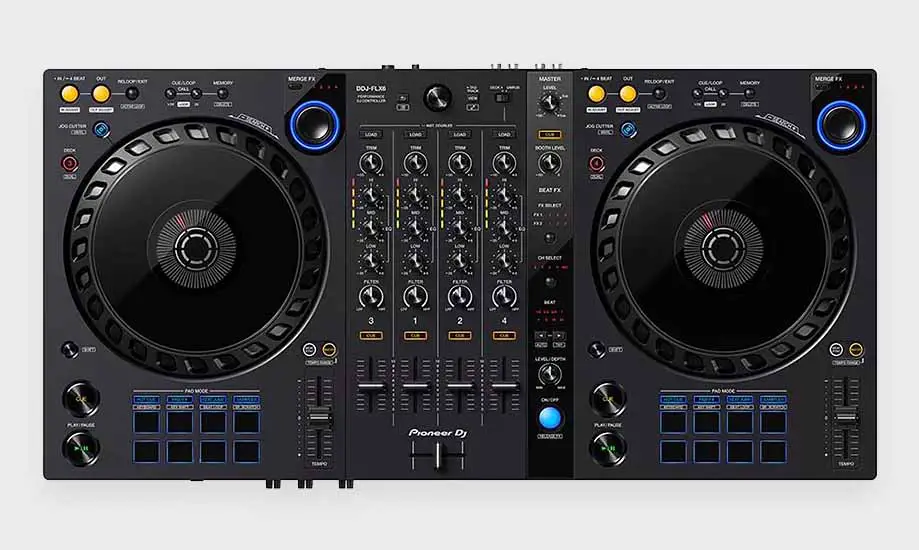 | Pioneer DDJ-FLX6: – 4 mixer channels available. – Large 8″ jog wheels. – Merge FX & Jog Cutter functions. | Check price on Amazon Check price on Ebay |
Pros & cons
Let’s quickly go over all the advantages and disadvantages of the Pioneer DDJ-FLX4 and the FLX6. Then we’ll get straight to the summary and the final verdict!
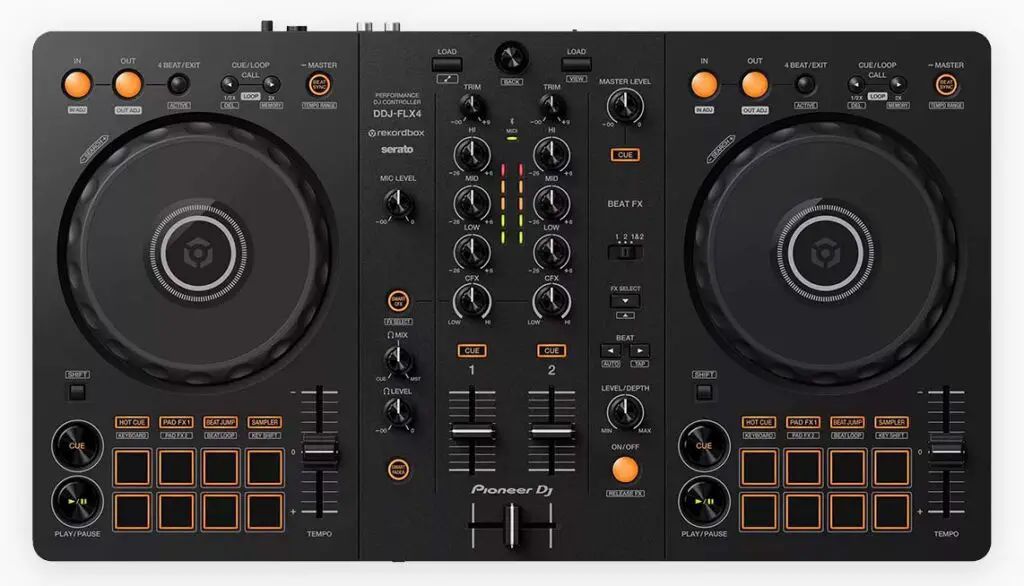
Pros:
- The reasonably priced successor of the Pioneer DDJ-400.
- Smart CFX & Smart Fader features.
- Kept all the core DDJ-400 features and added more.
- Compatible with both Rekordbox & Serato DJ.
Cons:
- Quite an average integration with Serato DJ software.
- Doesn’t unlock the full version of Serato DJ Pro anyway.
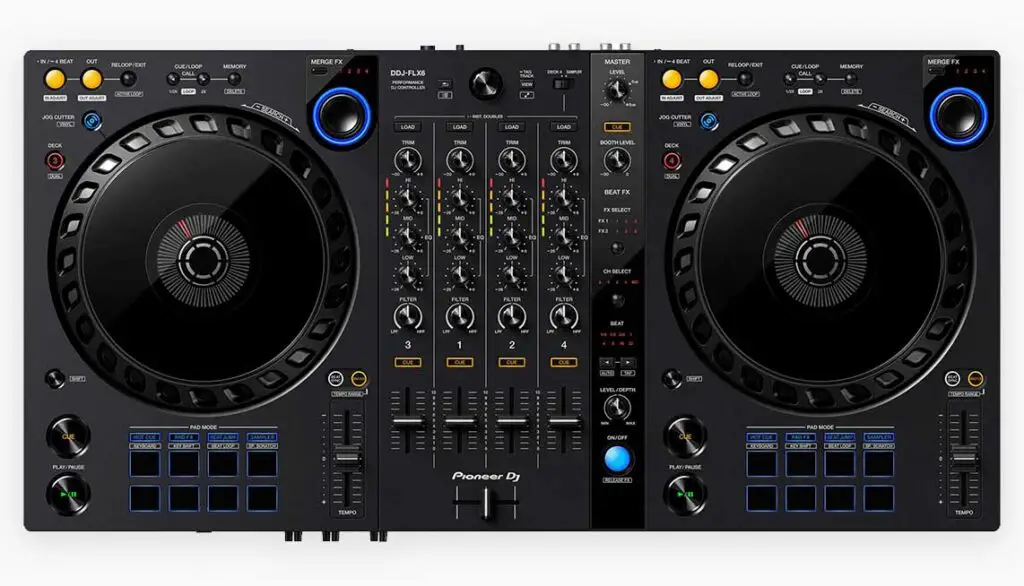
Pros:
- Full size 8″ capacitive jog wheels.
- 4 mixer channels on board.
- Merge FX & Jog Cutter features.
- Comes also in a graphite-colored variant.
- Compatible with both Rekordbox & Serato DJ (unlocks Serato DJ Pro).
Cons:
- No XLR outputs (just like on the FLX4).
- A quite clunky FX strip implementation.
- Still a bit limited when compared to only slightly pricier devices.
The conclusion – which one should you get?
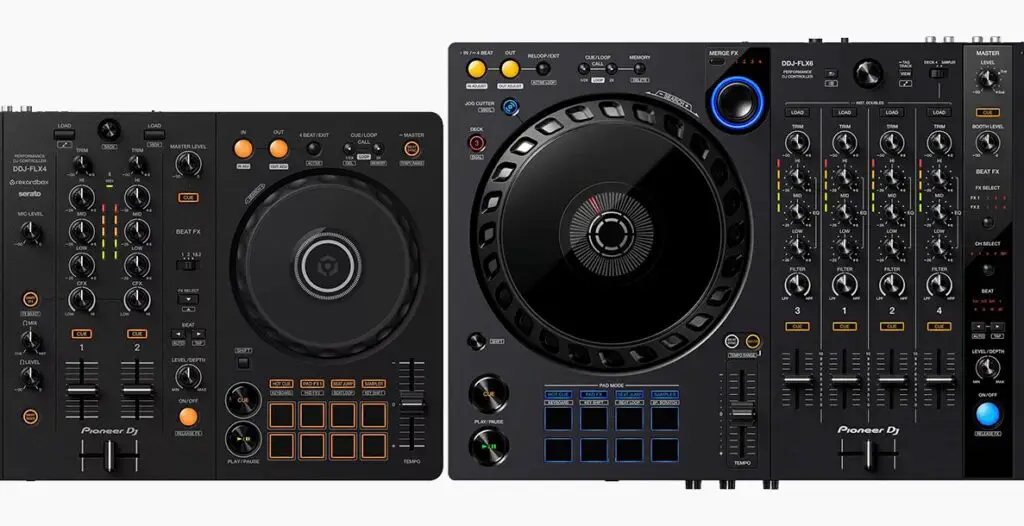
To sum it all up, the Pioneer DDJ-FLX4 is just as great of an entry-level DJ controller as its predecessor – the Pioneer DDJ-400. It’s a device that’s great for beginners, and it’s probably one of the best choices on the market right now when it comes to DJ controllers for people who want to smoothly get into DJing while not breaking the bank.
Pioneer DDJ-FLX6 on the other hand, is a small step up from the DDJ-FLX4’s feature set. It has 4 mixer channels and full-size 8-inch capacitive jog wheels on board, while still maintaining a very similar control layout to the one present on the FLX4. While the FLX4 features its brand new Smart CFX & Smart Fader FX, the FLX6 has its unique Merge FX & Jog Cutter FX combo.
If you can justify getting a larger 4-channel device for around double the price of the basic DDJ-FLX4, you can consider going for the FLX6.
Our advice here however, would be to either start off with the FLX4 and possibly upgrade later, or go straight for the higher priced semi-professional DJ controllers. The price of the DDJ-FLX6 (and the price difference between the FLX4 and the FLX6) hardly justify the purchase.
If you’re considering getting the Pioneer DDJ-FLX6, you could also go all-out and get yourself the best DJ controller in the league – the Pioneer DDJ-1000. Here is our detailed comparison of the DDJ-FLX6 and the DDJ-1000 if you’re interested: Pioneer DDJ-FLX6 vs. DDJ-1000 (Direct Comparison!)
And here are the options over on Ebay:
| Pioneer DDJ-FLX4 on Ebay: |
| Pioneer DDJ-FLX6 on Ebay: |

